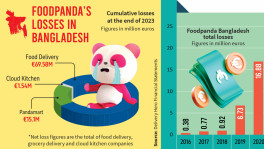Implementing car-free day can curb Dhaka traffic
Private cars account for just around 6 percent of passenger transport in cities. Shockingly, this paltry 6 percent of the users are occupying 76 percent of the streets

Every morning the city commuters have to brave the traffic within a very strict time frame to reach their destinations.
Ironically, the fight mostly takes the side of the traffic and thus fail these commuters to level-up with the office-clock.
The horrendous traffic congestion of Dhaka is now coupled with multiple mega-projects, which overtake the space of roads, eventually turning the traffic more unbearable.
Hence, city residents are seen struggling for a solution to get rid of this new-normal anomaly, which is ruining the work-life balance.
For a daily commuter in this bustling city, it is regular to overhear bus conductors hailing their voices echoing "plastics on the left".
Here, "plastic" is a popular colloquial term used by public bus community to refer to car-infestation on city roads.
In between this stark reality, how would it feel to know your roads will be made free of cars on selective days?
I believe this initiative of car-free day would definitely give you a sigh of relief since most initiatives to curb traffic congestion in this city did not work.
The aim for this special occasion is to strengthen the functionality of mass rapid transits and bus rapid transits by reducing private cars honking on city roads.

However, car-free zoning or car-holiday the not a new approach in celebrated metropolises.
The history dates back to 1970s, when Europe started celebrating car free days due to severe oil crisis. Subsequently, a theoretical design for a car free city was first proposed by J H Crawford in 1996 and further refined in his books, Carfree Cities and Carfree Design Manual.
For over a decade, the car-free day has acquired attention around the world. On 17 June 1997, Environmental Transport Association (ETA) in Britain officially introduced world's first national Car-Free Day.
And now, the 22nd day of September each year marks the World Car Free Day, which is celebrated around 4000 cities globally.
It is worth mentioning that Bangladesh is observing the World Car Free Day since 2006 at a non-governmental level.
Ten years later in 2016, it was observed jointly by the government and non-government organisations.
It is not necessary to reiterate how traffic congestion in Dhaka is paralysing public life.
Stark realities of the heavy costs incurred by this horrendous traffic congestion have been portrayed by numerous indices, statistics, literatures and experts' opinions.
The most striking one is, cars account for just around 6 percent of passenger transport in cities.
Shockingly, this paltry 6 percent of the users are occupying 76 percent of the streets.
Because, a private car carries 1-4 passengers occupying comparatively larger space on the streets while a bus can carry 30-50 passengers at a time.
Realising these harsh contrasts, the over-arching necessity for embracing car-free day or car-free zoning concept is mounting in Bangladesh.

It is really hard to imagine a world without cars; therefore, increasing number of cities are planning to revisit their existing trend of car mobility.
They are focusing on the reduction of private car use in city centers. Moreover, regulating cars' mobility in cities promoted reduced need for parking places and increase green space and networks in cities, leading to beneficial health effects.
Cities like Jakarta, Hamburg, Oslo, Bogota, Helsinki, Brussels, Madrid, Chengdu, Copenhagen, Dublin, Hyderabad, Milan and Paris have taken different measures aimed at reducing motorised traffic.
The measures include implementing car free days, investing in cycling infrastructure and pedestrianisation, restricting parking space and considerable increases in quality public transport provision.
In common, they all are following a framework integrating urban and transport planning with environmental and public health domains.
In this framework, urban planning leads to certain behaviour including transport mode choice and certain transport planning patterns for the city dwellers.
Unfortunately, Bangladesh has little or no integrated framework of this kind.
From the global best practices, it is quite common that policy packages are the key to push car-free plans forward.
Before restricting car mobility, it is imperative to provide a reasonable alternative with appealing features which the mass people can adapt to.
In this case, ensuring public transport availability, cycling infrastructure, green space and secure pedestrian areas can be the policy instruments that may compliment the bigger plan for car-free zoning.
Additionally, the planning of car free cities requires long term cross-party political commitment at the highest level.
Moreover, thorough assessment is needed to understand the dynamics of business viability and public acceptability.
However, the implementation process may not be straight forward as it may contain a multitude of policy measures.
In this connection, implementation plans may start with creating car free zones for selected part(s) of the city first and then introducing car free days.
In addition, a series of events can be organised to increase the appeal and significance of the measure and show examples of what could be done with the available space.
Furthermore, we need to ensure that car-free zoning must not be arranged to feed the media only, rather it should be organised in a manner that promote a good practice to ensure sustainability.
However, there will be uncertainties because in a city like Dhaka, where people become habituated with traffic congestion, they can't be freed from cars overnight (perhaps requiring significant reorganization of the city's transportation arrangement).
In addition, car-free zoning or car-free day cannot be implemented unless the government is seriously committed to it.

To receive the government commitment, concern about the socio-economic impacts by freeing specific streets from cars should be forecast and analysed in advance.
Thus, this would ensure a compatible relationship between local government and the residents, who will directly benefit from the programme.
Once smoking in public places and restaurants was acceptable, but later the move to regulate smoking was widely accepted and led to a significant reduction in exposure and improvement in public health.
I think the same may apply to regulate car-mobility in cities, which although may appear as a radical solution, could be embraced to have significant benefits in the long run.
The author is Research Associate at Bangladesh Foreign Trade Institute (BFTI)


 Keep updated, follow The Business Standard's Google news channel
Keep updated, follow The Business Standard's Google news channel
















